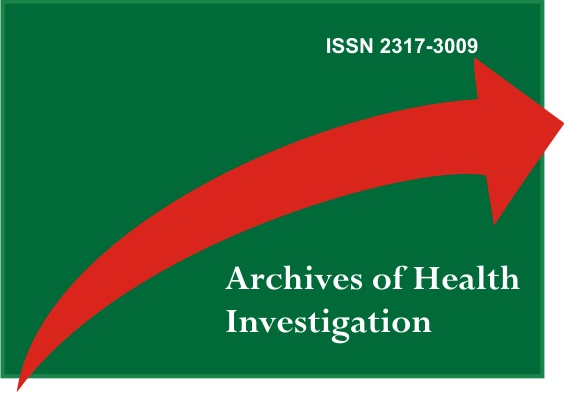Most Popular Gnathic Bones Injuries Diagnosed by Oral and Maxillofacial Pathology Laboratory of Universidade do Estado do Amazonas between 2012 and 2018
DOI:
https://doi.org/10.21270/archi.v11i3.5586Keywords:
Patology, Oral, Diagnosis, Oral, Jaw Diseases, Mouth DiseasesAbstract
Introduction: The gnathic bones sustain the teeth by alveolar bone and are in constant physiological adaptation in the oral environment. This dynamic with histological, functional and anatomical complex provides the ability to develop several pathologies to these bones, whose diagnosis is responsibility of dental surgeon. Objective: Recognize the most popular gnathic bones injuries which are diagnosed by Oral and Maxillofacial Pathology Laboratory of Universidade do Estado do Amazonas (SEPAT/UEA), a renowned public service in state. Material and Method: An epidemiological quantitative analytics research was conducted which analyzed reports issued between 2012 and 2018 by SEPAT/UEA, data about pathology an groups of pathologies, age, gender, location were collected and organized in tables and graphs. Results: Cysts represented 35,35% of cases, pulp and periapical pathologies 33,77% and odontogenic tumors 18,73%. Mandible was more affected (57%), preference for female gender (55,58%) and the most affected age group was 18 to 39 years old (36,47%) Conclusion: Clinical correlations are needed to pathologist give an accurate diagnosis, because some injuries are almost identical, nevertheless noting the results it was possible to perceive ever with peculiarities, the State follows the others in Brazil, changing the order in ranking.
Downloads
References
Grandi G, Maito FDM, Rados PV, Filho MS. Estudo epidemiológico das lesões ósseas diagnosticadas no serviço de patologia bucal da PUCRS. Epidemiological Study of Bone Lesions Rev cir traumatol buco-maxilo-fac. 2005;5(2):67-74.
Sugaya NN, Silva SS. Patologia Óssea. Fundamentos de Odontologia: Estomatologia. Rio de Janeiro: Guanabara Koogan; 2012.
Oliveira CNA. Epidemiologia das lesões fibro-ósseas benignas dos maxilares [dissertação]. Minas Gerais: Faculdade de Odontologia da Universidade Federal de Minas Gerais; 2016.
Noronha Santos Neto J, Cerre JM, Miranda AMMA, Pires FR. Benign fibro-osseous lesions: clinicopathologic features from 143 cases diagnosed in an oral diagnosis setting. Oral Surg Oral Med Oral Pathol Oral Radiol. 2013;115(5):e56-65.
Araújo, JP. Estudo epidemiológico, clínico e imaginológico das lesões ósseas dos maxilares [dissertação]. São Paulo: Faculdade de Odontologia da Universidade de São Paulo (USP); 2015.
Jiménez JS, Blanco FA, Arévalo RE, Martinez MM. Metástasis en hueso maxilar superior de adenocarcinoma de esófago. Presentación de un caso clínico. Med Oral Patol Oral Cir Bucal 2005;10:252-57.
Rutsatz K, Peter U, Beust M, Hingst V. Metastasis of bronchial carcinoma in the temporomandibular joint. Case report. Dtsch Stomatol 1990;40(11):477-79.
Bodner L, Geffen DB. Metastatic tumor of the jaw-diagnosis and management. Refuat Hapeh Vehashinayim 2003;20(1):59-61,81.
Azoubel Antunes, A, Pessoa Antunes, A. Metástases dos ossos gnáticos: estudo retrospectivo de 10 casos. Braz J Otorhinolaryngol. 2008;74(4):561-65.
Lourenço MSP. Patologia quística e tumoral dos ossos maxilares - Estudo observacional dos últimos 20 anos numa população portuguesa [dissertação]. Lisboa: Universidade de Lisboa; 2018.
El-Naggar AK, Chan JKC, Grandis JR, Takata T, Slootweg PJ. World Health Organization Classification of Head and Neck Tumours. 4th ed. Lyon: IARC; 2017.
Grossmann E, Cousen T, Grossmann TK, Bérzin F. Neuralgia induzida por cavitação osteonecrótica. Rev Dor. 2012;13(2):156-64.
Regezi JÁ, Sciubba JA. Patologia bucal: correlações clinicopatológicas. 3 ed. Rio de Janeiro: Guanabara Koogan; 2000.
Costa FM. Evaluation of musculoskeletal tumors in the new era of artificial intelligence. Radiol Bras.2018;51(6).
Dunfee BL, Sakai O, Pistey R, Gohel A. Radiologic and pathologic characteristics of benign and malignant lesions of the mandible. Radiographics. 2006;26(6):1751-68.


